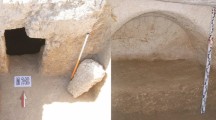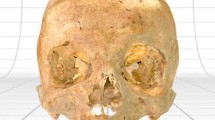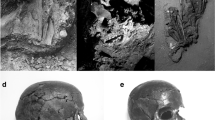Abstract
Facial reconstruction is employed in medical science and archaeology. Though quite popular as anthropological method, it has not so far been used in the orthodox ecclesiastical tradition. This work presents the facial reconstruction of St Eftychios of Crete, who lived between the ninth and tenth centuries. Computed tomography and reverse engineering methods were employed to complete the task. Reconstruction of the mandible and the missing left zygomatic arch was implemented following the Sassouni method. The American method was followed for the soft tissues, with clay deposition of appropriate thickness, on the surface of the skull model. The eyes, nose, and lips were added based on the dimensions of the underlying bone structures. Long hair and beard were added, according to the classic Byzantine tradition pattern of the time period. The final bust developed was then digitized, using a 3D non-contact laser scanner. The 3D geometry produced was employed to produce a mold with vacuum casting techniques. This mold provides the ability to produce copies of the bust, if needed. At the same time, a realistic 3D representation of the Saint’s bust was developed, with the aid of special software, in order to compare the traditional forensic reconstruction to the pure digital one. This work is the first case of a Saint’s facial reconstruction in the Orthodox Church. The facial reconstruction process, with all the limitations considered, offers the ability to present a realistic aspect of a Greek Orthodox Church Saint, in a form that is easily accessible. Both physical and digital facial reconstruction processes were based on scientific data, so they were as accurate as possible, considering that the mandible was missing in the skull. The facial reconstruction was entirely implemented in Greece creating the basis for similar work in the future. The final bust developed was donated to the Odigitria Monastery, to be exhibited to its visitors.
Access this chapter
Tax calculation will be finalised at checkout
Purchases are for personal use only
Similar content being viewed by others
References
Cavanagh D, Steyn M (2011) Facial reconstruction: Soft tissue thickness values for South African black females. Forensic Sci Int 206(1–3):215.e1–7
Cheilakou E, Troullinos M, Koui M (2014) Identification of pigments on Byzantine wall paintings from Crete (14th century AD) using non-invasive Fiber Optics Diffuse Reflectance Spectroscopy (FORS). J Archaeol Sci 41:541–555. ISSN 0305-4403. https://doi.org/10.1016/j.jas.2013.09.020
Claes P, Vandermeulen D, De Greef S, Willems G, Clement JG, Suetens P (2010) Computerized craniofacial reconstruction: conceptual framework and review. Forensic Sci Int 201(1):138–145
Davy SL, Gilbert T, Schofield D, Evison MP (2005) Forensic facial reconstruction using computer modelling software. Computer-Graphic Facial Reconstruction, Elsevier Academic Press, pp 183–196. ISBN 9780124730519
De Greef S, Claes P, Vandermeulen D, Mollemans W, Suetens P, Willems G (2006) Large-scale in-vivo Caucasian facial soft tissue thickness database for craniofacial reconstruction. Forensic Sci Int 159:S126–134
Dou P, Wu Y, Shah SK, Kakadiaris IA (2018) Monocular 3D facial shape reconstruction from a single 2D image with coupled-dictionary learning and sparse coding. Pattern Recognit 81:515–527
Evison MP, Sayado E, Iwamura M, Guimaraes MA, Schofield D (2016) Forensic reconstruction and its contribution to identification in missing person cases. Handbook of Missing Persons.https://doi.org/10.1007/978-3-319-40199-7_28
Galdames ICS, Lopez MC, Matamala DAZ, Rojas FJP, Munoz SRT (2008) Comparisons in soft-tissue thicknesses on the human face in fresh and embalmed corpses using needle puncture method. Int J Morphol 26:165–169
Gerasimov MM (1971) The face finder. Lippincott, New York
Guyomarch P, Stephan CN (2012) The validity of ear prediction guidelines used in facial approximation. J Forensic Sci 57(6):1427–1441
Guyomarch P, Veleminsky P, Bruzek J, Lynnerup N, Horak M, Kucera J, et al (2018) Facial approximation of Tycho Brahe’s partial skull based on estimated data with TIVMI-AFA3D. Forensic Sci Int 292:131–137
İşcan MY. Sreyn M (2013) The human skeleton in forensic medicine. Charles C. Thomas, Springfield
Jo J, Kim H, Kim J (2017) 3D facial shape reconstruction using macro- and micro-level features from high resolution facial images. Image Vis Comput 64:1–9
Katsumura S, Sato K, Ikawa T, Yamamura K, Ando E, Shigeta Y, et al (2015) High-precision, reconstructed 3D model of skull scanned by conebeam CT: reproducibility verified using CAD/CAM data. Leg Med (Tokyo) 18:37-43
Killgrove K (2015) Bones of Saint Nicholas Reveal What Santa Claus Really Looked Like. Forbes Magazine
Kranioti EF (2014) Craniometric Analysis of the Cretan population. Proceedings of the 1st International Multidisciplinary Conference on the history and civilisation of Southern Crete «ΕνΓορτύνη και Αρκαδία εγένετο», Messara, Crete, Greece. Psilaki E, Drakakis M (eds) Heraklion, pp 615–623
Kranioti EF, Langstaff H, Garcia-Donas JG (2015) Cranial variation of the Ibizan populations. Monograph of Meeting of VI JornadesD’arqueologia de les IllesBalears (Archaeological conference of the Balearic Isles), Formentera, 26th September 2014. Consel insular de Formentera, Formentera, pp 273–284
Krogman WM, İşcan Y (1986) The human skeleton in forensic medicine. Charles C. Thomas, Springfield
Krogman WM, Sassouni V (1957) Syllabus in Roentgenagraphic Cephalonetry. Philadelphia Center for Research in Child Growth
Madentzoglou MS, Kranioti EF, Michalodimitrakis M (2014) Facial reconstruction methods in Forensic Anthropology and Archaeology. Proceedings of the 1st International Multidisciplinary Conference on the history and civilisation of Southern Crete «ΕνΓορτύνη και Αρκαδία εγένετο», Messara, Crete, Greece. Psilaki E, Drakakis M (eds) Heraklion, pp 611–614 (article in Greek)
Mahoney P, Carr D, Harisson K, McGuire R, Hepper A, Flynn D, et al (2018) Forensic reconstruction of two military combat related shooting incidents using an anatomically correct synthetic skull with a surrogate skin/soft tissue layer. Inte J Leg Med. https://doi.org/10.1007/s00414-018-1802-z
Maravelakis E, David K, Antoniadis A, Manios A, Bilalis N, Papaharilaou Y (2008) Reverse engineering techniques for cranioplasty: a case study. J Med Eng Technol 32(2):115–121
Mazura JC, Juluru K, Chen JJ, Morgan TA, John M, Siegel EL (2012) Facial recognition software success rates for the identification of 3D surface reconstructed facial images: implications for patient privacy and security. J Digit Imaging 25(3):347–351
Nagpal S, Singh M, Jain A, Singh R, Vatsa M, Noore AS (2017) On matching skulls to digital face images: a preliminary approach. 2017 IEEE International Joint Conference on Biometrics (IJCB), Denver, CO, pp 813–819. https://doi.org/10.1109/BTAS.2017.8272775
Nelson LA, Michael SD (1998) The application of volume deformation to three-dimensional facial approximation: a comparison with previous techniques. Forensic Sci Int 94(3):167–181
Papagrigorakis MJ, Synodinos PN, Antoniadis A, Maravelakis E, Toulas P, Nilsson O (2011) Facial reconstruction of an 11-year-old female resident of 430 BC Athens. Angle Orthod 81(1):169–177
Papagrigorakis M, Kousoulis A, Synodinos P (2014) Craniofacial morphology in ancient and modern Greeks through 4,000 years. Anthropol Anz 71(3):237–257
Parks CL, Monson KL (2018) Biometric correspondence between reface computerized facial approximations and CT-derived ground truth skin surface models objectively examined using an automated facial recognition system. Forensic Sci Int 286:8–11
Pascual LC, Redondo CL, Sanchez BR, Garrido DG, Galdon AS (2011) Computerized Three-Dimensional Craniofacial Reconstruction from Skulls Based on Landmarks. 2011 Federated Conference on Computer Science and Information Systems (FedCSIS), pp 729–735. ISBN 978-83-60810-22-4
Pavlica TM, Rakić RS, Božić-Krstić VS, Srdić-Galić BĐ (2018) Secular trend of head and face shape in adult population of Vojvodina (Serbia). Ann Hum Biol 45(4):330–336. https://doi.org/10.1080/03014460.2018.1452981
Phillips VM, Smuts NA (1996) Facial reconstruction: utilization of computerized tomography to measure facial tissue thickness in a mixed racial population. Forensic Sci Int 83:51–59
Prag AJNW (1990) Reconstructing King Philip II: The “Nice” Version. Am J Archaeol 94(2):237–247
Prag J, Neave R (1997) Making faces: using forensic and archaeological evidence. British Museum Press
Rhine JS, Moore CE (1984) Facial reproduction tables of facial tissue thickness of American caucasoids in forensic anthropology. Maxwell Museum of Anthroplogy, The University of New Mexico
Sassouni V (1957) Palatoprint, physioprint, and roentographiccephalometry, as new methods in human identification. J Forensic Sci 2(4):429–443
Sfakiotakis E, Manios A (2005) Digital anatomy and the software ‘Anatomos’. Hellenic Plastic Surgery 2:151–158, ISSN 1109-3994
Short LJ, Khambay B, Ayoub A, Erolin C, Rynn C, Wilkinson C (2014) Validation of a computer modelled forensic facial reconstruction technique using CT data from live subjects: a pilot study. Forensic Sci Int 237:147.e1–147.e8
Snow C, Gatliff BP, McWilliams KR (1970) Reconstruction of facial features from the skull: an evaluation of its usefulness in forensic anthropology. Am J Phys Anthropol 33:221–228
Somos C, Rea P, Shankland S, Kranioti E (2019) Medical imaging and facial soft tissue thickness studies for forensic craniofacial approximation: a pilot study on modern Cretans. Biomedical Visualisation. Series: Advances in experimental medicine and biology. Springer Nat 2 (1138): 71–86. ISBN 9783030142261. https://doi.org/10.1007/978-3-030-14227-8_6
Spradley K, Stull KE, Hefner JT (2016) Craniofacial secular change in recent mexican migrants. Hum Biol 88(1):15–29
Taylor K (2001) Forensic art and illustration. CRC press
Tedeschi-Oliveira SV, Beaini TL, Melani RFH (2016) Forensic facial reconstruction: Nasal projection in Brazilian adults. Forensic Sci Int 266:123–129
Utsuno H, Kageyama T, Uchida K, Yoshino M, Miyazawa H, Inoue K (2010) Facial soft tissue thickness in Japanese children. Forensic Sci Int 199(1–3):109.e1–109.e1096. https://doi.org/10.1016/j.forsciint.2010.02.016
Vandermeulen D, Claes P, Loeckx D, De Greef S, Willems G, Suetens P (2006) Computerized craniofacial reconstruction using CT-derived implicit surface representations. Forensic Sci Int 159:S164–S174
Vanezis M, Vanezis P (2000) Cranio-facial approximation in forensic identification—historical development and a review of current practice. Med Sci Law 40(3):197–205
Weisensee KE, Jantz RL (2011) Secular changes in craniofacial morphology of the Portuguese using geometric morphometrics. Am J Phys Anthropol 145(4):548–59. https://doi.org/10.1002/ajpa.21531. Epub 2011 May
Wilkinson C (2005) A review of forensic art. Forensic Sci Med Pathol 5:17–24
Wilkinson C (2008) Forensic Facial Reconstruction Cambridge University Press
Wilkinson C (2010) Facial reconstruction – anatomical art or artistic anatomy? J Anatom 216:235–250
Wilkinson C (2015) Computerized forensic facial reconstruction, a review of current systems. Res Rep Forensic Med Sci 1(3):173–177
World Congress on Anthropology (1884) Frankfurt, Germany
Zanatta A, Bezzi L, Carrara N, Moraes C, Thiene C, Zampieri F (2018) New technique in facial reconstruction: the case of Giovanni Battista Morgagni. AnthropolAnz 75(2):131–140
Zacharopoulos G, Manios A, De Bree E, Kau CH, Petousis A, Zacharopoulou I, Kouremenos N (2012) Neoclassical Facial Canons in Young Adults. J Craniofac Surg 23(6):1693–1698
Zacharopoulos G, Manios A, Kau CH, Velegrakis G, Tzanakakis G, De Bree E (2016) Anthropometric Analysis of the Face. J Craniofac Surg 27(1):71–75
Acknowledgments
Authors would like to thank journalist and writer Psilakis Nikos for his contribution in the acquirement of the Saint’s skull from the monastery, sculptor Papadoperaki Aspasia for the artistic diligence of the hair and beard on the physical bust, mandible surgeon Fragakis Marios for the support in the construction of the Saint’s mandible, mechanical engineer Mountakis Nikos for his contribution in the digital bust development, the Forensic Department, the Radiology Department, the Dental clinic and the Plastic surgery unit, of the Surgical Oncology clinic, of the General University Hospital of Heraklion for their technical support in the implementation of this work. This work is dedicated to the memory of Manolis Michalodimitrakis, Professor of Forensic Medicine at the University of Crete, beloved mentor, collaborator, and friend, who passed away in 2016.
Authors’ Contribution
Vidakis Nectarios: concept/design, data analysis/interpretation, drafting of the manuscript, critical revision of the manuscript, and approval of the manuscript.
Petousis Markos: concept/design, acquisition of data, data analysis/interpretation, drafting of the manuscript, 3D modeling, and 3D printing processes.
Nathena Despoina: anthropological analysis, interpretation, discussion of the results, and review of the manuscript.
Kranioti Elena: anthropological analysis, interpretation, discussion of the results, and review of the manuscript.
Manios Andreas: concept/design, acquisition of data, data analysis/interpretation, drafting of the manuscript, approval of the article, physical bust development.
Compliance with Ethical Standards
Dis-closure of Potential Conflicts of Interest
The authors declare that they have no conflict of interests.
Research Involving Human Participants and/or Animals
This article does not contain any studies with human participants or animals performed by any of the authors. The manuscript does not include images that contain identifiable patients or human subjects.
Informed Consent
Informed consent is not applicable in the study.
Funding
No funding was received for this work.
Author information
Authors and Affiliations
Corresponding author
Editor information
Editors and Affiliations
Rights and permissions
Copyright information
© 2021 The Author(s), under exclusive license to Springer Nature Switzerland AG
About this chapter
Cite this chapter
Vidakis, N., Petousis, M., Nathena, D., Kranioti, E.F., Manios, A. (2021). Forensic Recreation and Visual Representation of Greek Orthodox Church Saint Eftychios of Crete. In: Rea, P.M. (eds) Biomedical Visualisation. Advances in Experimental Medicine and Biology, vol 1317. Springer, Cham. https://doi.org/10.1007/978-3-030-61125-5_2
Download citation
DOI: https://doi.org/10.1007/978-3-030-61125-5_2
Published:
Publisher Name: Springer, Cham
Print ISBN: 978-3-030-61124-8
Online ISBN: 978-3-030-61125-5
eBook Packages: Biomedical and Life SciencesBiomedical and Life Sciences (R0)




